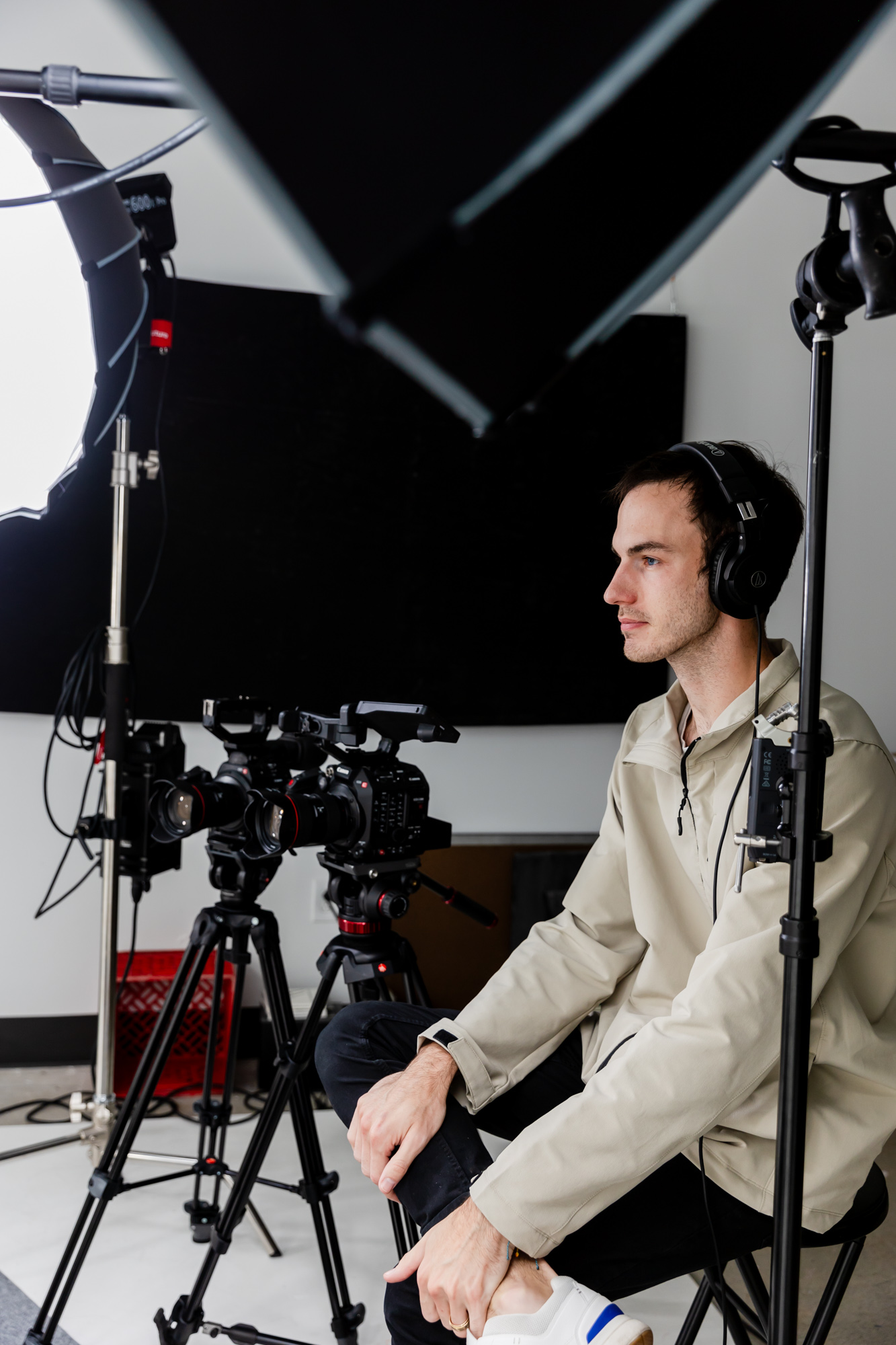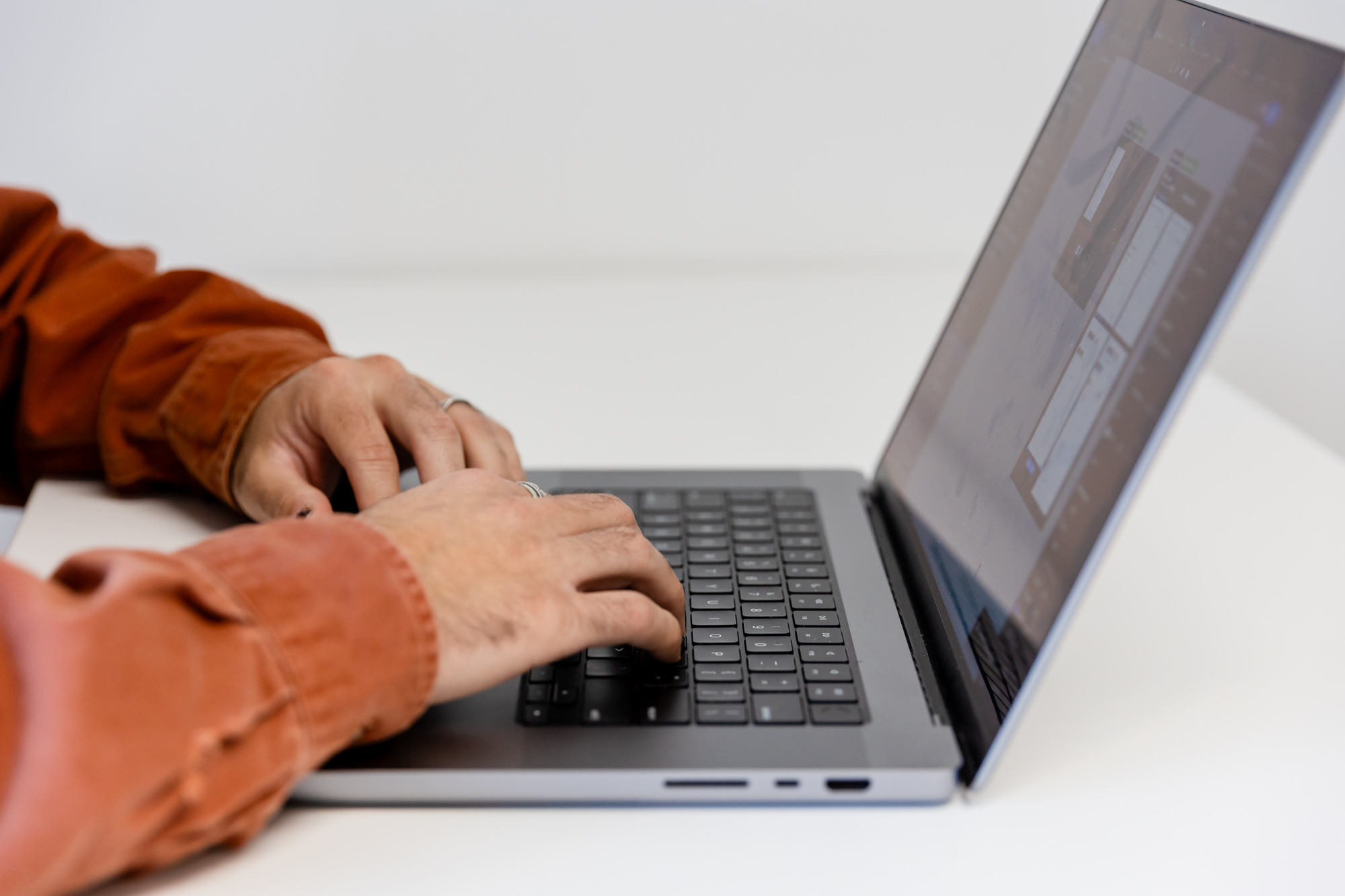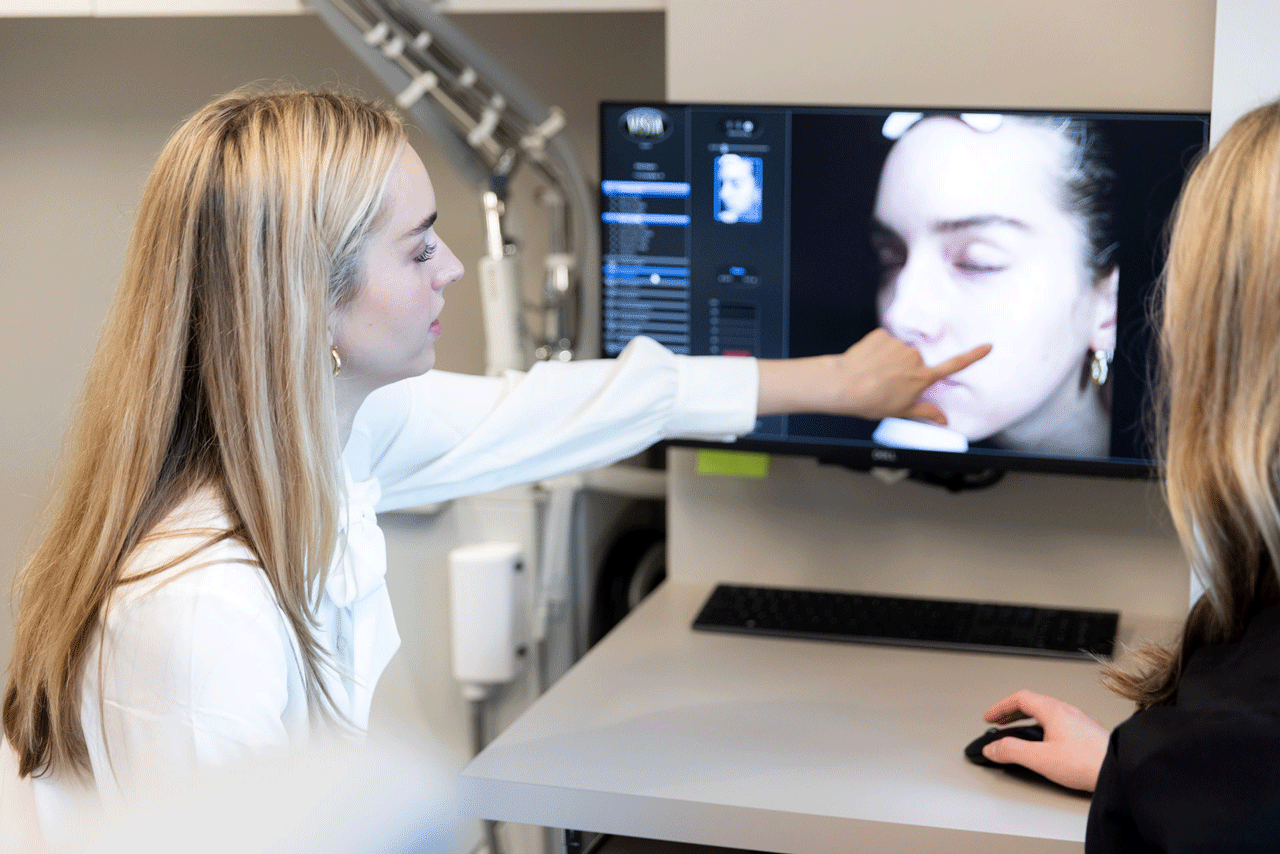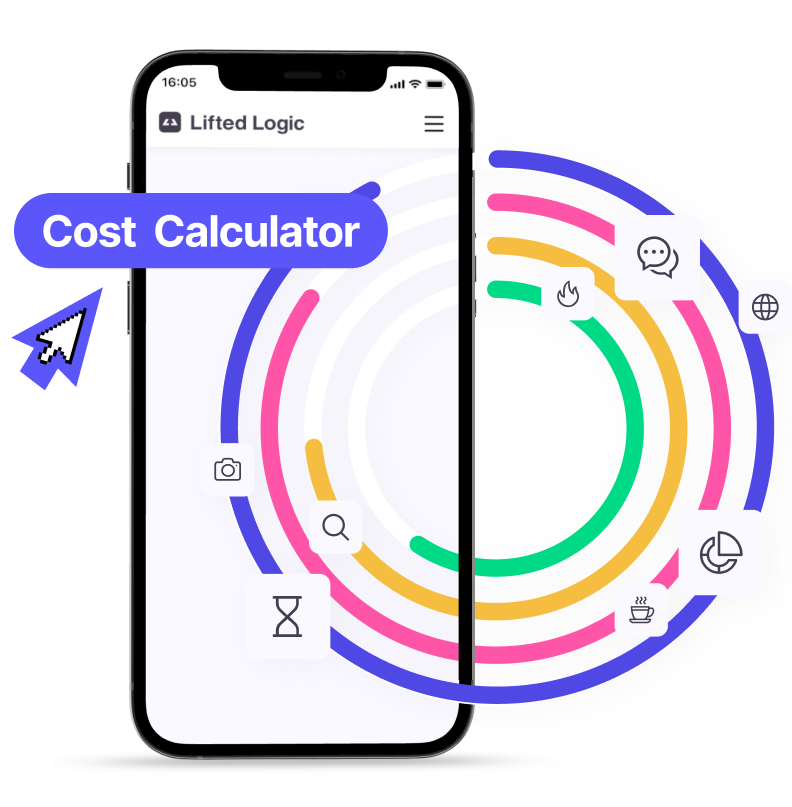If you’ve read Part 1 on podcasting, you’ve got an idea of what your podcast is about, who you’re talking to, and most importantly—why you want to podcast in the first place. Now, you need the equipment to create the podcast.
In the next few podcast blog installments, I’m going to take you on a 10,000-foot tour of the recording landscape. It can be a true, merciless rabbit hole of tech, or it can be easy-peasy and kind of fun. Sure, it can be both, but I’m going to lean toward the easy-peasy for now. Should you want to go deep, we have a team of audio and video professionals who can help you figure out your situation and show you how to gather the best audio for your podcast.
As for me, I’m Mark Groves, copywriter for Lifted Logic, and 30+ year radio veteran, podcaster, terrible guitar player, and audio designer. Quite a bit of the info you’ll read here I wrote as part of a college course I taught in the Kansas City area.
Sharing knowledge? I dig it. Now let’s talk tech.
The Basics
This is the simple part, where we map out what needs to be done:
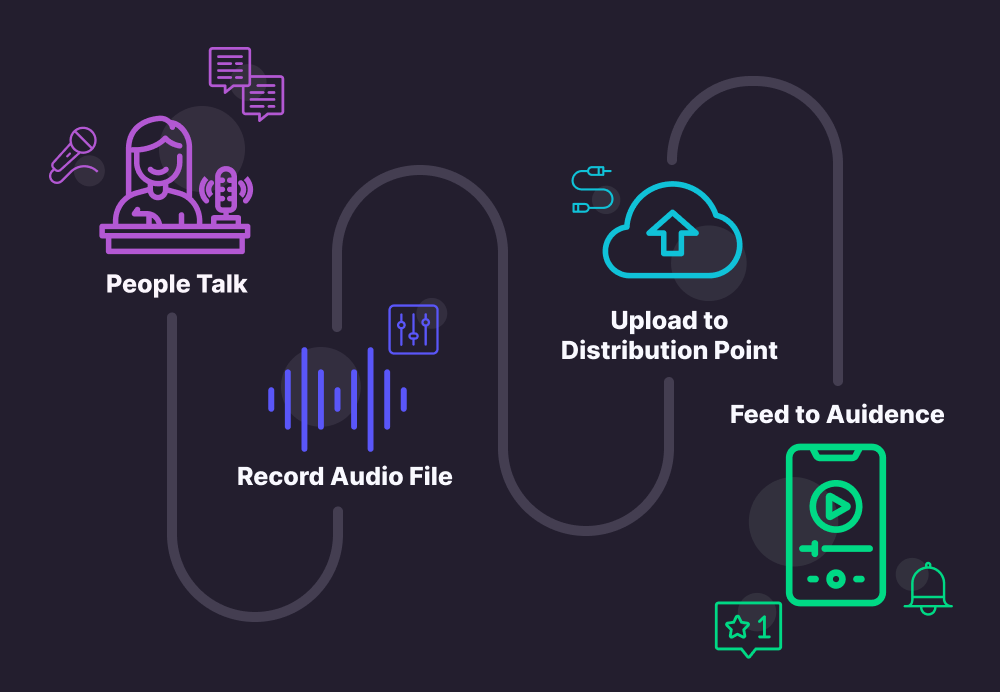
Seems super simple, but the tech involved can make it sound either cheap and unlistenable or juicy and rich. The recorded audio file can be mixed down with music/sfx, or kept to just voices. The hosting/distribution point can range from a very expensive paid service all the way to free.
And a surprisingly large number of sources feed podcasts to listeners (Apple Podcasts, Spotify, Stitcher, Google Podcasts, and a BUNCH more). You can even feed it through multiple sources to saturate the listening market.
That’s the easy part. Now to make decisions on how deep to go into the rabbit hole of podcasting microphones and mixers.
Capturing Voices: Podcasting Microphones
The device into which you speak is the beginning of the audio chain and makes all the difference for how your podcast will sound. A lousy microphone means lousy source audio. So you’ll need to think about how you’re going to record the podcasts. These are a few of the things you’ll want to consider before purchasing your microphone:
- Will you be on the go anywhere (maximum mobility & agility)?
- Will you have a dedicated space to record?
- How much can you take with you to the places you want to record?
- What’s your budget?
- Does guest impression of your “professionalism” matter?
- Do I want analog-to-digital, or a fully digital audio chain?
Let’s look at some options, starting small and building up from there.
Smartphone Mic Recording
You can capture the voice audio on a smartphone. However, I highly recommend you don’t use the phone’s built-in microphone. That’s designed for phone calls, and won’t capture “distant” voices well, even when set to speakerphone.
Microphones exist that plug into your phone, and you should choose one of these to get the best audio you can and use the phone to store that audio file.
If you choose to record via your phone, you should also get some kind of stand so that you don’t have to hold the phone as you record. Hand-holding the phone (or any microphone) while recording can cause several kinds of unwanted movement noises that end up detracting from the audio.
You will most likely need some kind of recording app installed, too, to capture the best audio. And keep in mind: you have to get the audio out of the phone. Will you upload the raw, unedited audio as your podcast? Will you import it into an audio editor to clean it up, and maybe add music or a pre-recorded introduction (“intro”) to the front and maybe music/’outro” audio to the back? Will it go to a company/employee to manipulate?
Sidenote: phones are not the best way to capture Zoom/digital meeting audio. Even Zoom isn’t the best way to capture audio.
If you want to record the audio from a video meeting, do some homework researching possibilities, and then test them out. You might start with Riverside.fm, a free service which records both audio and video, and you can download the files. Or maybe Callcast.co. Good luck!
Studio Microphones
Now we’re getting fancy. Ish. Adjacent. Compatible.
Before purchasing a non-smart-phone mic, you’ll need to know not only what kind of mic to purchase for your situation, but also how you’re going to get the mic or multiple-mic audio into the recording source.
Let’s start with the two different types of microphones: condenser, and dynamic.
Analog vs Digital Microphones
Just to clarify: all mics start as “analog.” Your sound source (voice, instrument, dog howl, whatevs) creates sound waves.
These sound waves (changes in air pressure) hit the microphone’s diaphragm, like how they hit your eardrum. The diaphragm moves, and the electronics to which it is connected create a tiny electric current. Voiláa—analog audio signals created right off the starting line.
Now, how that tiny electric current is interpreted is what decides how the mic will operate for us. The analog electric current can be continued on the analog path from the mic to some kind of amplification, like a mic preamp or a mixer board.
Or the mic itself interprets the tiny electrical current as a digital signal and sends that out from the mic into whatever recording device you use, making it a digital microphone.
For example, an analog mic can be hooked up to an analog mixer board and used as a P.A. mic. It can be connected to the mic input on small hand-held devices, such as a Zoom or Tascam portable recorder. Or it can be plugged into a digital converter, say a Focusrite Scarlett Solo, which converts that electrical signal into digital information (frequently delivered via USB) that your computer “records.”
A “digital” microphone outputs the digital information from that original analog electrical signal to the next part of your audio chain, be it a digital mixer board, or straight into a computer. This kind of microphone has a built-in analog-to-digital (ADC) converter. Unless the microphone is built with both sets of electronics so it can be used as either analog or digital, it will have to hook up to a digital device.
Let’s face it: no matter which way you go, the audio will end up in a digital form, because we’re talking about a podcast here, which is inherently digital. So it would almost seem a digital mic is the premier choice; however, that’s not necessarily true.
The pros of analog mics:
- Larger selection of mics
- Bigger variety of specialized applications
- Can work in non-digital environments
The cons of analog mics:
- Must have outboard converter if going into digital source
- Not as simple to hook up to a computer as a digital mic
You’ll have to decide how “easy” you want your setup to be. Keep in mind that if you want multiple mics, you will most likely need some kind of mixer board where all the mics feed into. You’ll control their volume on the mixer board, and then the board sends that combined audio as a stereo feed to the recorder.
Condenser Microphones
A condenser microphone requires a power source to function. Because it has an external power source, it’s usually very sensitive to minute sounds. It can pick up audio more readily.
Condenser mics are usually only found in a studio. They tend to be more delicate, and don’t travel as well as the other type of mic. You can buy high-dollar condenser mics that stand up well to traveling…but did I mention high-dollar? Check out the mic brand “Neumann.” Fantastic mics, expensive, and brutally honest when it comes to picking up every sound possible.
Dynamic Microphones
A dynamic microphone almost never needs external power. They can be quite sturdy, but also less responsive than a condenser mic. A dynamic mic is the usual choice for stage mics, and for studios that aren’t as well sound-proofed. They’re also generally better-suited for microphone users who don’t worry about how they handle the mic.
Seriously—look up YouTube videos on the Shure SM58 dynamic mic, and add the word “durability” into your search. Then cringe as the mic gets run over by trucks, microwaved, doused in beer and sea water, used to hammer nails, and even grilled with bratwursts—and continues working.
Dynamic mics run the cost gamut from inexpensive to extremely expensive.
How do I decide between dynamic and condenser mics?
It totally depends on where and how you plan to use the mic, such as:
Noisy Recording Environment
You’ll want a less sensitive mic (so which would this be?), and you’ll want it to be able to sound good when it’s closer to your mouth/voice.
Traveling Recording Sessions
You’ll want a mic (which one?) that is sturdy enough to handle the bumps and drops of being handled a lot, and one that can handle both quiet and noisy recording environments.
Quiet, Non-Mobile Recording Environment
Think about how close you want the mic in this environment. If you want it further away for good eye-to-eye contact, or you want a universal, single mic to pick up all voices, you’ll want a more sensitive mic.
What about having one microphone in the middle of a table?
This is certainly a choice. You’ve probably seen YouTube podcast recordings where 2 or more people use a centrally located microphone. You run the risk of having audio bounce/reverberation off the hard table/counter surface, but it’s not the worst choice.
If you want to go with this lowest-tech setup, look for a microphone that has an omnidirectional recording mode. That means it’s picking up audio 360 degrees, from every direction. Most microphones don’t do that, but that’s one of those tech rabbit holes, and I’m trying to keep the plane at 10k feet of view. Ask us about mic patterns if you want to dig deeper into podcasting microphones and mixers.
What’s a mixer board for when a computer has an audio input jack?
Mixer boards control the sound levels and sources. A computer’s audio jack has audio in, and audio out. That’s it. A mixer board is the traffic light and the bridge between multiple sources- microphones, audio players, and other outboard audio sources- and the computer.
Need three microphones live while recording a podcast? Use a mixer board. Want to record a band? Use a mixer board. They can be analog or digital.
But wait—there are mixers that record, too!
I’m kind of in love with how tech has evolved. The rise of podcasts created a whole new arena of home recording, and in that arena lives wonderful toys like the RODEcaster Pro.
Yes, I own one, but I’m using it as one example of any number of multi-functional integrated audio production tools.
Imagine a “mixer” that can handle 4 analog microphones (sorry, no digital on this one), 4 headphone outputs, AND a full bank of sound effects that play at the touch of a button. You could have your short audio introduction already set up.
You hit the button to play the intro music/sfx, record your podcast, hit a button to play your outro music, and voila—you’re recorded. That audio can then be downloaded via usb to your computer.
But wait, there’s more. With this board, you can also take a phone call. Or feed your computer out and into the board as an audio source so you can record Zoom interviews. Or use the board to feed digitally into a computer as you record.
You can even record a phone interview via bluetooth! So much yes.
It is versatile, and it works with analog mics so you have a huge world of audio gathering devices from which to choose. The RODECaster isn’t the only brand doing this, so look at price points, and at what you want/need the board to accomplish. This might work better for you than a mixer board. And it’s portable! I’ve done remote recording sessions with mine, and love it.
Make Decisions, and Then Get the Toys
As part of your decision making process for podcasting microphones and mixers, if you don’t have somewhere to try out the mics, try out youtube. There are so many demonstration videos of practically every popular mic that exists. Listen to the demos, read the reviews, and make choices.
You’ll also need:
- Mic stands (Tabletop/Floor-standing/Scissor boom, etc)
- Cables (XLR/ USB/Different lengths from mic to connection/etc)
- Storage (cover for the mixer to protect from dust, carrying cases, etc.)
- Headphones (for you, for your guests)
- And maybe outboard speakers to play the audio in-studio (like from the RODECaster pro)
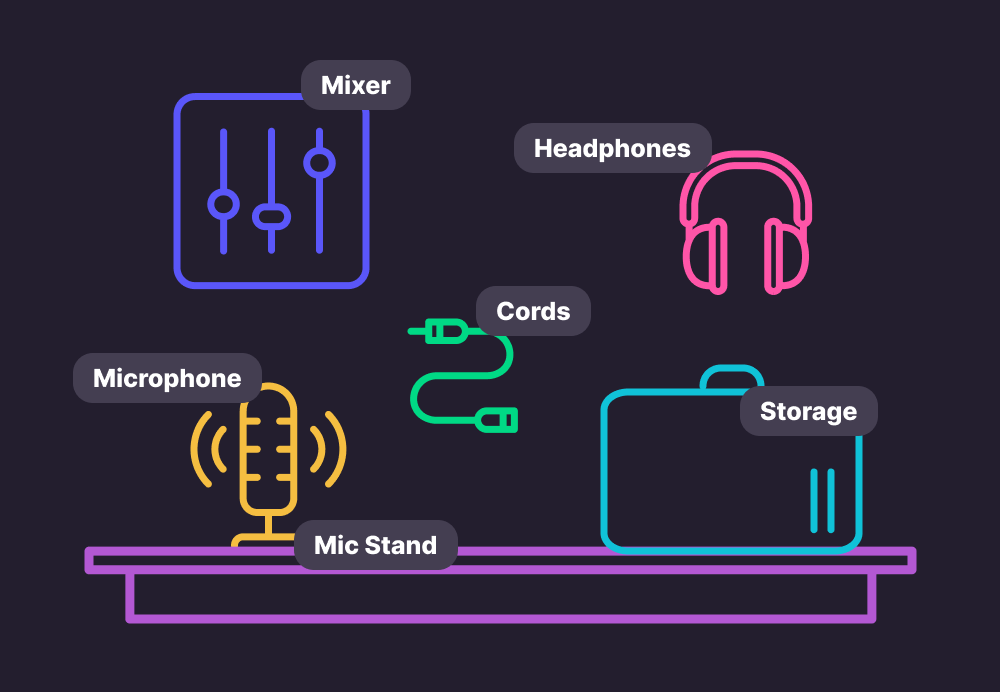
You can find decent, industry standard mics for as little as around 100 dollars each. Mixer boards can be truly inexpensive, too. The integrated studio boards run a few hundred dollars, but for all the equipment they replace, they make sense.
So basically, you could start for a few hundred dollars, or a truckload of benjamins. Only you can decide what your starting investment level should be.
Podcasting and Lifted Logic
At Lifted Logic, we’re not only a website design company. We create targeted content in print, audio, video, and more. If it’s digital, we’ve got creatives on staff who understand it and love doing it.
We can record your podcasts for you, including as video also if you wish. As part of your content creation, this option can get you the podcasts you want, but without having to worry about equipment, studio space, or mixing time.
Contact us at Lifted Logic, and let’s talk about what you want to talk about, and how we can make that happen. And watch for our next podcast blog, where we discuss the recording process.
